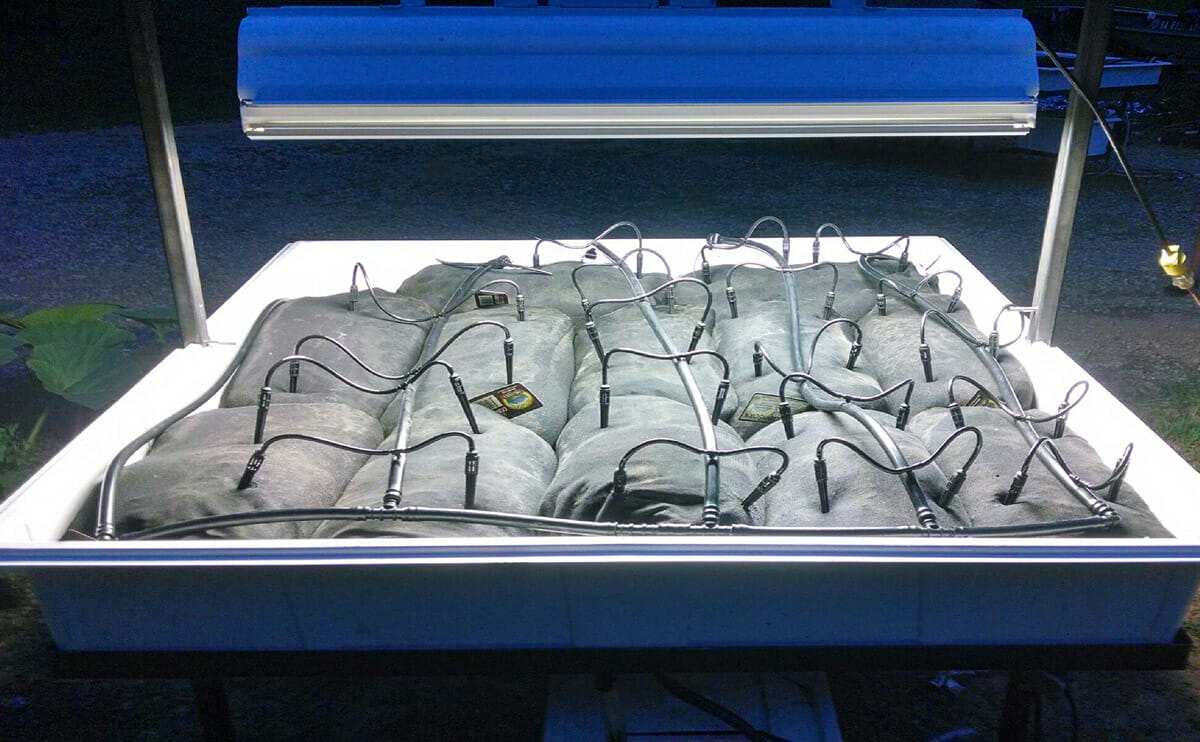Virginia's champion pumpkin grower has invented a product to revolutionize world hunger. It's a lot like a sock.

“Have you ever heard of ripe strawberries in September?” he asked. His technique, while still in testing, was a tweaked version of his pumpkin-growing method. There was possibility, though, and he’d have a heck of story to tell the world soon. He was bursting with the manic ambition that drives people to grow half-ton pumpkins just because.
And sure enough, months later, Layton began calling again. At his test facility in an abandoned greenhouse in Lynchburg, Virginia, he had kept on harvesting ripe strawberries clear through the polar vortexes of early 2014. He says the newfangled system he and his partners had built to grow winter strawberries would work with any other fruit or vegetable, too, 365 days a year, with very little water or power and no fertilizers or chemicals at all.
“This is a pretty big deal,” he says, enthusiastic as ever. “We really believe that this will end world hunger and end food deserts across the United States and across the world.”
“We really believe that this will end world hunger and end food deserts across the United States and across the world,” says William Layton
For the past several years, Layton has been using compost to grow his pumpkins in his back yard. His special trick? Training the vines along a series of compost-filled fabric tubes. He figured he’d try out the method with other vegetables, and before long, was hawking a consumer version through his company, Blue Ridge Organics.
One of the really exciting bits for Layton was the fact that a few compost tubes plopped down pretty much anywhere amounted to an instant garden, if the weather was amenable. Growers of giant pumpkins, though, aren’t used to playing by the rules that the world generally sets for horticulture; Layton wasn’t done yet. With the help of a few partners, he set up shop in the abandoned greenhouse to figure out if he could sideline that pesky weather concern and stretch the growing season into a repeating, year-round cycle.
He built a structure to hold some compost tubes. He put in a drip irrigation system capable of recycling any nutrient-loaded water that drains out of the compost. He rigged up some magnetic induction lighting, and when the weather got cool, set up some infrared heaters for supplemental heat in the greenhouse. The result: fresh strawberries in January.
[mf_mosaic_container columns=”2″ captions=”yes”]
[mf_mosaic_item src=”https://modernfarmer.com/wp-content/uploads/2014/09/LaytonsSocks_1.jpg” number=”1″ caption=”Layton harvested strawberries through the bitterly cold polar vortex weather of early 2014.”]
[mf_mosaic_item src=”https://modernfarmer.com/wp-content/uploads/2014/09/LaytonsSocks_2.jpg” number=”2″ caption=”William Layton’s son is somewhat less excited about BroGro photos than William Layton.”]
[/mf_mosaic_container]
“It was special for us because we were told that it wouldn’t happen,” says Kevin Camm, an extension agent in Lynchburg who helped Layton on the strawberry experiments last fall and winter. (Camm and several other Virginia Cooperative Extension agents provided some assistance and expertise during the winter trials in the abandoned Lynchburg greenhouses.)
Layton says a patent is pending on what he’s calling the BroGro System, the “Bro” bit being a nod to Blue Ridge Organics. He now has higher hopes than just making some money on the idea. He’s trying to deploy the BroGro in the fight against global hunger. During the first week of August, Layton was in Washington, D.C., for the U.S.-African leaders summit, pitching BroGro to a delegation from an African country that he declines to name at the moment (he is optimistic this nation will be putting in orders soon.) Ever since the dead-of-winter strawberry harvest, Layton’s been at full-tilt: arranging distribution, getting his new business entity up and running, going a million miles an hour. “I’m holding onto the train and trying to keep up with it,” he says.
Commercial BroGro sales will be a custom, turnkey deal, Layton says. Every system includes the basics: growing tables, the “growing medium” (a proprietary derivation of his Blue Ridge Organics’ super compost), a lighting system and a recirculating drip irrigation system. Beyond that, Layton and company intend to deliver whatever else a client needs to make their on-demand farm ready to bloom — greenhouses, solar panels for electricity, heating systems, etc.
Later this fall, BroGro will also debut to the general public in variously sized DIY units — 4’x8′, 4’x4′, 2’x4′ — that can form the building blocks of an instant, year-round, low-input garden. These will likely retail for around $1,000 to about $6,000, depending on the size.
[mf_mosaic_container columns=”2″ captions=”yes”]
[mf_mosaic_item src=”https://modernfarmer.com/wp-content/uploads/2014/09/LaytonsSocks_3.jpg” number=”1″ caption=”BroGro testing in an abandoned greenhouse in Lynchburg, Va., yielded a cabbage half the size of Layton’s son.”]
[mf_mosaic_item src=”https://modernfarmer.com/wp-content/uploads/2014/09/LaytonsSocks_4.jpg” number=”2″ caption=”Layton says magnetic induction lighting and a recirculating drip-irrigation system make the BroGro system extremely efficient.”]
[mf_mosaic_item src=”https://modernfarmer.com/wp-content/uploads/2014/09/LaytonsSocks_5.jpg” number=”3″ caption=”Some of the BroGro basics: table, growing medium and an irrigation system.”]
[/mf_mosaic_container]
“You can put [these] anywhere in the world and be growing immediately. And I proved that it works,” Layton says.
In his backyard pumpkin patch, where this all began, Layton has a few giant pumpkins coming along. This year’s crop didn’t get the sort of 24/7 attention that truly gargantuan pumpkins need, but Layton has a good excuse. It’s a tradeoff Virginia’s champion giant pumpkin grower is willing to make.
“Helping feed the world would be a whole lot more important to me,” he says. “Pumpkins are still just a hobby.”